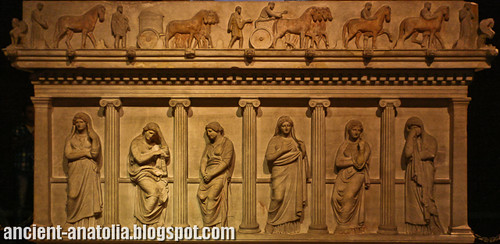
The Sarcophagus of the Crying Women in Istanbul Archaeology Museum, found at the Royal Necropolis in Sidon.

It is the best example of the group called by archaeologists "Sarcophagi with Columns". From the partial traces on the marble that remained until today, it is understood that it had been dyed in blue and red initially. Nothing could be found other than the bones of its owner and a bronze belt buckle inside, since it had been robbed in an earlier times. It is considered as a final resting place, like the "Mausoleum of Halicarnassus" or the "Nereid Monument", rather than a tomb.
Its architectural features were used in the architecture of the old building of the İstanbul Archaeological Museums. It is an example of the Greek sculpture displaying Eastern influences. The shaved heads, bear feet, ragged clothes of the figures and their movements and expressions of sadness are features of Semitic societies. It is thought to be the sarcophagus of the King of Sidon, Straton (374-358 BC), who was said to have led a life of pleasure. The sarcophagus has the shape of an Ionian temple.
It is thought that the figures of 18 sad women between the columns represent the wives of the dead person or the women in his seraglio, rather than crying women who were common in the Middle Eastern countries.